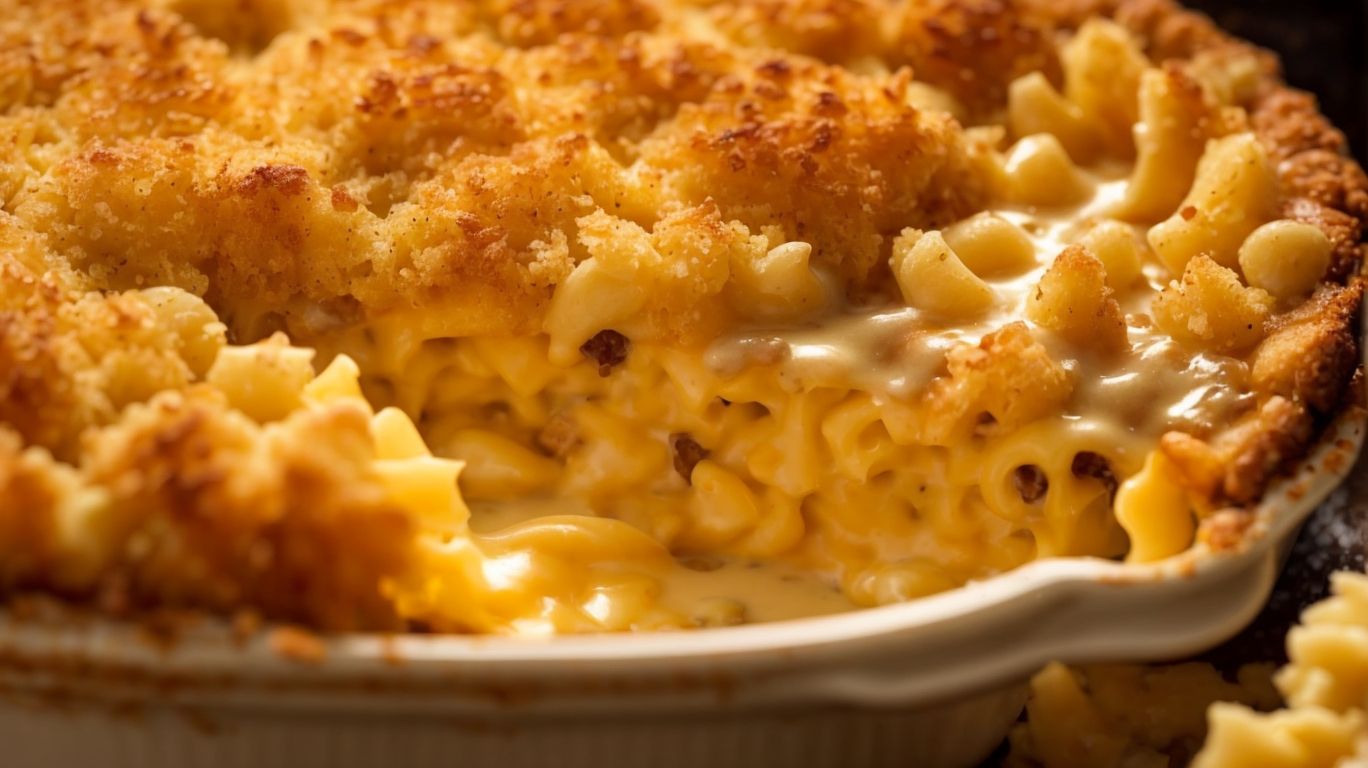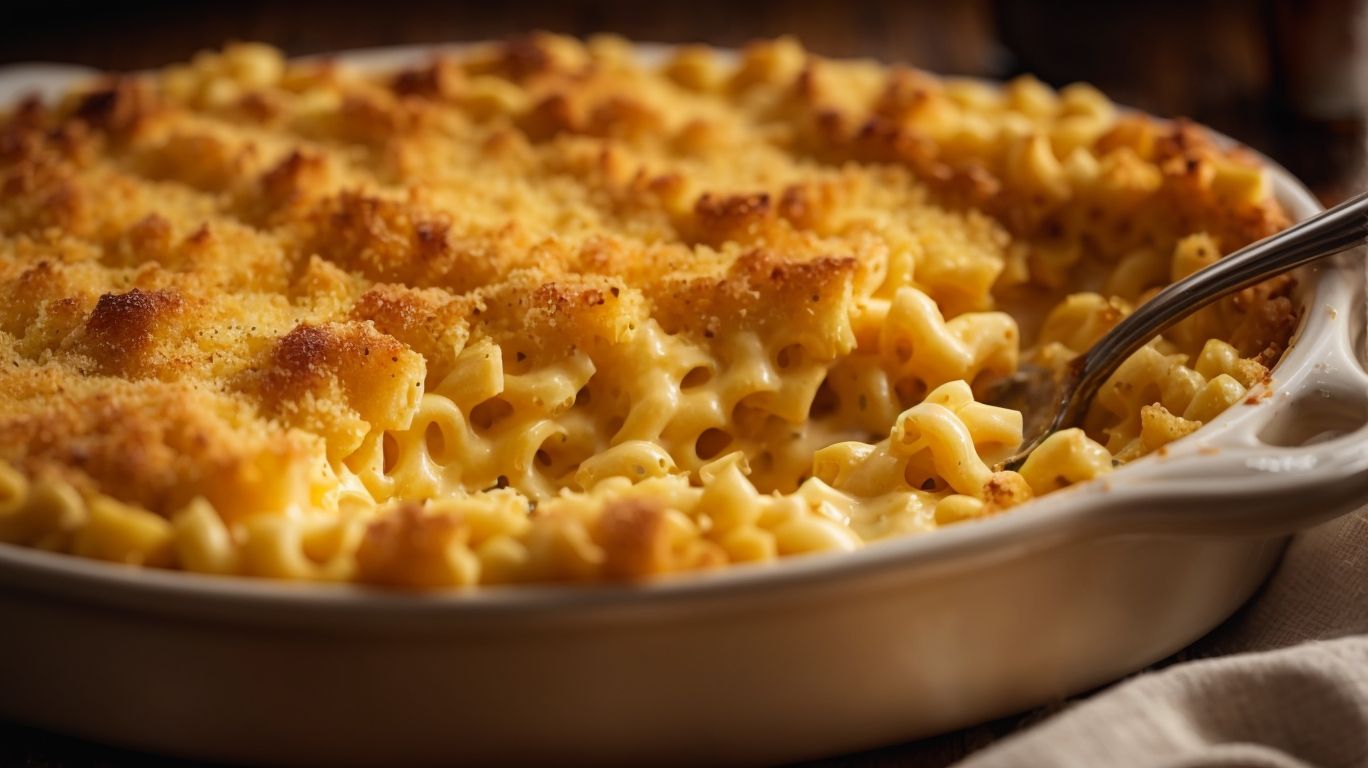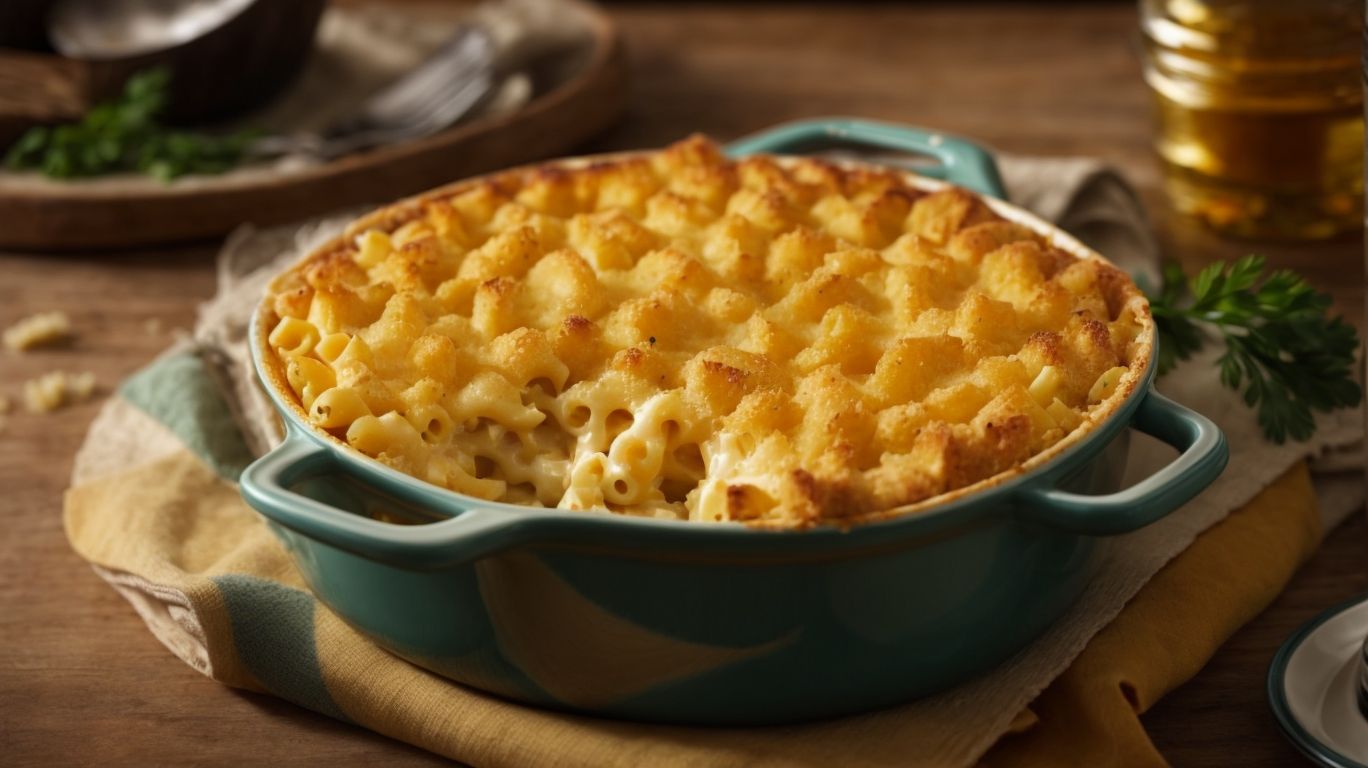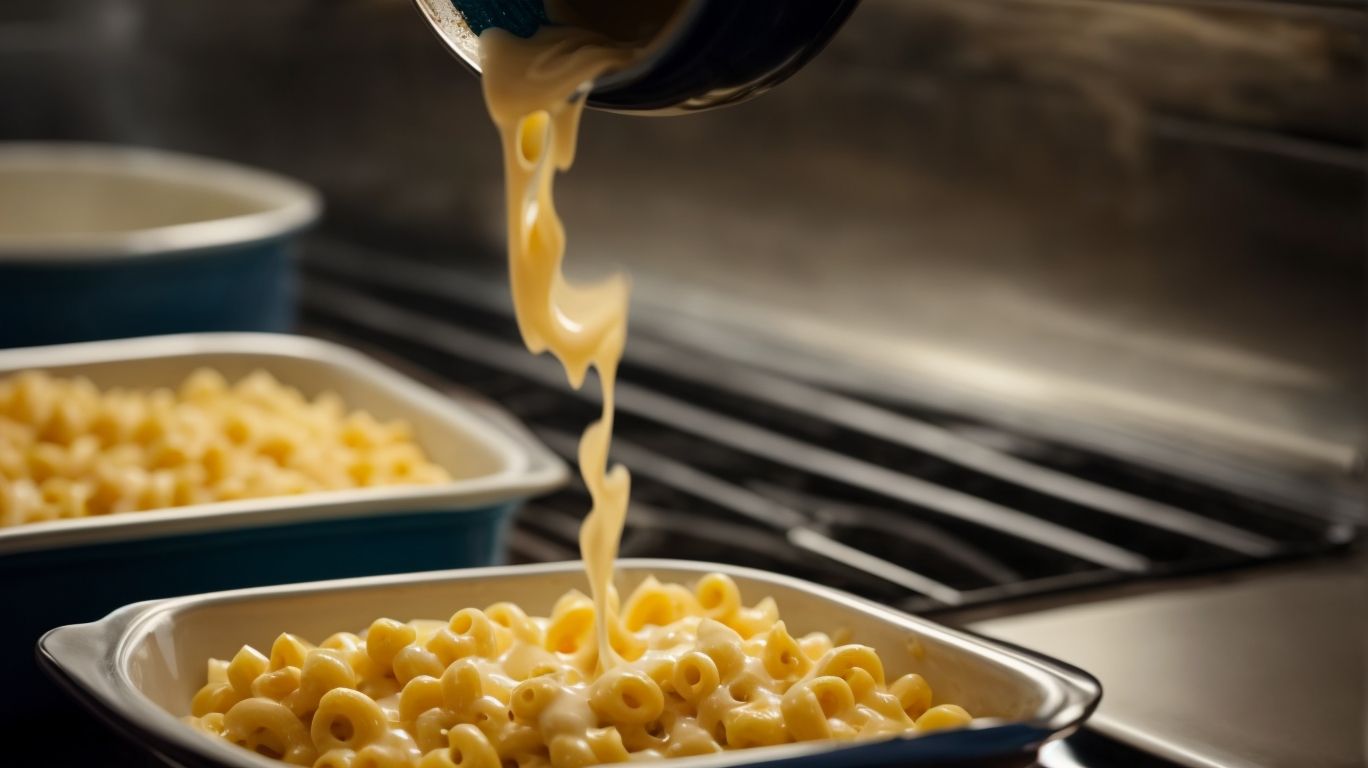How to Bake Mac and Cheese?
Craving the comforting and cheesy goodness of mac and cheese? Look no further!
We will explore the key ingredients needed to make this classic dish, the steps to create the perfect mac and cheese, various delicious variations to try, and tips on serving and storing leftovers.
Whether you’re a mac and cheese aficionado or a newbie in the kitchen, this guide will have you whipping up a delectable batch in no time. Let’s get cooking!
Key Takeaways:
What Ingredients Do You Need to Make Mac and Cheese?
To make the perfect Mac and Cheese, you need a combination of key ingredients such as pasta, a blend of cheeses including cheddar, gruyere, and mozzarella, a creamy sauce made with butter and milk, and a delicious topping for that final touch.
Starting with the pasta, it provides the base and texture essential for a satisfying Mac and Cheese experience. Choose a pasta shape like elbow macaroni or shells to cradle the cheesy goodness.
Next, the diverse cheese selection is crucial for depth of flavor – whether melting cheddar for richness, gruyere for nuttiness, or mozzarella for gooeyness.
The creamy sauce acts as the binding agent, bringing all the components together harmoniously. The combination of butter, milk, and cheese creates a velvety, indulgent sauce that envelopes each pasta piece.
The delectable topping adds a contrasting crunch or burst of flavor to enhance the dish further.
How to Make the Perfect Mac and Cheese?

Credits: Poormet.Com – Jason Thompson
Creating the perfect Mac and Cheese involves a series of steps such as cooking the pasta to al dente, preparing a rich cheese sauce with a medley of cheddar, gruyere, and mozzarella, and carefully combining the pasta and sauce for a creamy blend.
Once the pasta reaches al dente perfection, drain it thoroughly, preserving a bit of pasta water to help bind the sauce later on. The key to a decadent cheese sauce lies in the combination of different cheeses, where the sharpness of cheddar complements the nuttiness of gruyere and the gooeyness of mozzarella.
Utilizing a roux as the base, melt butter in a pan, whisk in flour, and gradually add milk to achieve a smooth consistency. Grate the cheeses finely and add them to the roux, stirring constantly until they melt into a luscious sauce.
What Are Some Variations of Mac and Cheese?
Dive into the culinary world of Mac and Cheese variations, including the classic Baked Mac and Cheese, the luscious Creamy Stovetop Mac and Cheese, a delectable Vegan Mac and Cheese, and a gluten-free twist on this beloved dish.
Let’s start with the traditional Baked Mac and Cheese. This version usually features a crispy breadcrumb topping that adds a delightful crunch to the creamy cheese sauce and al dente pasta.
Moving on to the Creamy Stovetop Mac and Cheese, it’s all about the velvety smoothness achieved through a blend of cheeses like sharp cheddar and creamy Gruyère.
Now, imagine a plant-based twist with Vegan Mac and Cheese, where ingredients like cashews, nutritional yeast, and plant-based milk mimic the rich and cheesy flavor of the original.
For those with gluten sensitivities, the Gluten-Free Mac and Cheese offers a satisfying alternative using gluten-free pasta and a homemade cheese sauce sans wheat.
Each variation of Mac and Cheese brings its own flair, making it a versatile dish suited for different dietary preferences and taste buds.
How to Serve and Store Mac and Cheese?

Credits: Poormet.Com – Jordan Wilson
Discover the best practices for serving and storing Mac and Cheese, from creative serving suggestions to effective methods of storing leftovers and handy tips for reheating this creamy and cheesy delight.
Regarding serving Mac and Cheese, presentation can make all the difference. Enhance the visual appeal by sprinkling some freshly chopped parsley or a drizzle of truffle oil on top before serving. You can also consider serving in individual ramekins or mini cast iron skillets for a charming touch.
As for storing leftovers, transfer the Mac and Cheese into airtight containers or wrap it tightly with plastic wrap to preserve its freshness.
To reheat your leftover Mac and Cheese without compromising its flavors, consider adding a splash of milk or cream to maintain its creamy texture. Opt for reheating in the oven at a low temperature to prevent drying out the dish. Stirring in a bit of additional cheese before reheating can also revitalize the flavors and add extra cheesiness.
Pasta
The foundation of a great Mac and Cheese dish lies in the quality of the pasta used.
When preparing Mac and Cheese, choosing the right type of pasta is crucial for achieving the perfect texture and flavor. Traditionally, elbow macaroni is the classic choice due to its tubular shape that holds the creamy cheese sauce well. Variations such as shell pasta or cavatappi can also work wonderfully as they trap the cheesy goodness within their crevices.
Cooking the pasta to the right level of al dente is essential to prevent it from becoming mushy when combined with the cheese sauce. Remember to salt the pasta water generously to enhance the overall taste of the dish.
Cheese
The cheese selection is a crucial element in determining the flavor profile and creaminess of your Mac and Cheese.
Regarding crafting the perfect Mac and Cheese dish, choosing the right combination of cheeses is essential for achieving that gooey, melty texture and rich taste that everyone craves.
- Cheddar is a popular choice, known for its sharp and tangy flavor that adds depth to the dish.
- Gruyere, with its nutty notes, brings a touch of sophistication and complements the cheddar perfectly.
- For those seeking a stretchy, stringy texture, mozzarella can be a fantastic addition, blending seamlessly with the other cheeses for a luscious mouthfeel.
And let’s not forget about the creamy varieties like brie and fontina, which add a luxurious creaminess that elevates the dish to a whole new level of decadence.
Milk
Milk plays a vital role in creating the creamy texture and richness of the cheese sauce in Mac and Cheese.
Regarding achieving that velvety smooth consistency, the quality and type of milk used are paramount. Whole milk, with its higher fat content, brings a luxurious creaminess that takes the cheese sauce to another level. The proteins and sugars in the milk also contribute to the overall texture, helping to bind all the flavors together seamlessly. Whether you opt for cow’s milk, goat’s milk, or even a dairy-free alternative like almond milk, the essence of milk in this classic comfort food creation remains irreplaceable.
Butter
Butter adds a velvety smoothness and rich flavor to the cheese sauce, enhancing the overall taste of Mac and Cheese.
Butter, with its creamy essence, melds effortlessly into the tangy cheese, creating a luscious sauce that coats every strand of pasta in decadence.
The emulsifying properties of butter help bind the cheese molecules together, resulting in a silky amalgamation that tantalizes the taste buds.
The gentle nuttiness of butter plays harmoniously with the sharpness of the cheese, striking a perfect balance of flavors that elevates this classic comfort dish.
Flour
Flour acts as a thickening agent in the cheese sauce, ensuring a smooth and velvety consistency in Mac and Cheese.
When incorporated into the sauce, flour’s starch content absorbs liquid and swells, creating a thicker, more luscious texture. This process helps bind all the ingredients together, preventing any unwanted separation of liquids. Additionally, flour plays a crucial role in maintaining the sauce’s stability, ensuring it doesn’t become too runny or overly thick. Whether you opt for a traditional roux-based sauce or a gluten-free alternative like cornstarch, the choice of flour can greatly impact the overall mouthfeel of your Mac and Cheese.
Seasonings
Seasonings are the secret ingredients that elevate the flavors of Mac and Cheese, making each bite a delightful experience.
Regarding selecting seasonings for your Mac and Cheese, there are endless possibilities to tantalize your taste buds.
Experimenting with different combinations can take this classic dish to a whole new level of deliciousness. Whether you prefer a bold and spicy kick or a more subtle and aromatic flavor, there’s a perfect seasoning for everyone.
Popular choices include paprika, garlic powder, onion powder, mustard powder, black pepper, and even a hint of cayenne for those who love a bit of heat. Mixing and matching these seasonings allows you to create a customized flavor profile that suits your preferences.
Remember, balance is key when seasoning your Mac and Cheese. Too much of one spice can overpower the dish, while a careful blend of complementary seasonings can enhance the overall taste without overwhelming it. Don’t be afraid to get creative and add a sprinkle of fresh herbs like parsley or chives for a final touch of freshness and color.
How to Serve and Store Mac and Cheese?

Credits: Poormet.Com – Christopher Moore
Discover the best practices for serving and storing Mac and Cheese, from creative serving suggestions to effective methods of storing leftovers and handy tips for reheating this creamy and cheesy delight.
Regarding serving Mac and Cheese, presentation can make all the difference. Consider garnishing with crispy bacon bits or fresh herbs for an extra touch of flavor and visual appeal. Serving individual portions in ramekins or small skillets can also elevate the dining experience.
For storing leftovers, transfer the Mac and Cheese into an airtight container and refrigerate promptly. To maintain its creamy texture, avoid freezing if possible, as it can sometimes alter the consistency upon thawing.
When reheating, add a splash of milk or cream to the dish before gently warming it on the stovetop or in the microwave. This helps in restoring the luscious creaminess and prevents the cheese from becoming greasy.
Cook the Pasta
Cooking the pasta to perfection is a critical step in ensuring the ideal texture and consistency of your Mac and Cheese dish.
When preparing the pasta for your Mac and Cheese, begin by bringing a large pot of water to a rolling boil. Add a generous amount of salt to the water to enhance the flavor of the pasta. Once the water is boiling, gently drop the pasta into the pot, making sure to stir it immediately to prevent sticking. Maintain a steady boil, and stir occasionally to ensure even cooking.
Frequent tasting is key to determining the pasta’s doneness. The pasta should be cooked until it is al dente, which means it should have a slight firmness when bitten into, without being hard or crunchy. This perfect balance ensures that the pasta holds its shape and texture when mixed with the creamy cheese sauce.
Make the Cheese Sauce
Crafting a velvety and flavorful cheese sauce is the heart of creating a delectable Mac and Cheese masterpiece.
One of the key elements in achieving a luscious cheese sauce is selecting the right blend of cheeses. A combination of sharp cheddar, creamy Gouda, and a hint of Parmesan can elevate the flavor profile to new heights. To enhance the creaminess, incorporating a touch of heavy cream or whole milk while gradually whisking in flour to create a roux forms the base of the sauce.
As the roux thickens, adding warm milk slowly and continuously stirring ensures a smooth consistency. Infusing flavors with a pinch of nutmeg or mustard powder can add depth and complexity to the sauce.
Combine the Pasta and Sauce
The magic of Mac and Cheese happens when the perfectly cooked pasta is enveloped in the luscious cheese sauce, creating a harmonious blend of flavors and textures.
Once the pasta is al dente, it’s time to bring together the star of the show – the cheese sauce. Gently pour the velvety sauce over the pasta, ensuring every strand is coated in creamy richness. Using a spatula or wooden spoon, delicately toss the pasta and sauce until they become one, with the cheese evenly coating each piece. The heat from the pasta will help the cheese sauce to adhere and melt perfectly, creating a luxurious and indulgent dish.
What Are Some Variations of Mac and Cheese?
Dive into the culinary world of Mac and Cheese variations, including the classic Baked Mac and Cheese, the luscious Creamy Stovetop Mac and Cheese, a delectable Vegan Mac and Cheese, and a gluten-free twist on this beloved dish.
Regarding Baked Mac and Cheese, it’s all about that crispy golden topping that adds a delightful crunch to the creamy goodness beneath. Imagine layers of velvety cheese sauce oozing between perfectly cooked elbow macaroni before being baked to perfection.
For those who prefer their Mac and Cheese with a smooth and velvety texture, the Creamy Stovetop version is a go-to choice. The secret lies in the combination of cheeses and a touch of seasoning that creates a harmonious symphony of flavors.
For a plant-based twist, the Vegan Mac and Cheese offers a dairy-free alternative without compromising on taste. Nutritional yeast, cashews, or plant-based cheese substitutes come together to create a creamy and satisfying dish that even non-vegans will love.
And let’s not forget about those with dietary restrictions – the Gluten-Free Mac and Cheese caters to those who need to avoid gluten without sacrificing the essence of this comfort food favorite. Using gluten-free pasta and a blend of flavorful cheeses, this version proves that dietary restrictions don’t have to mean missing out on delicious meals.
Baked Mac and Cheese
Indulge in the rich and comforting flavors of Baked Mac and Cheese, a classic variation that combines a crispy topping with a creamy and cheesy interior, garnished with fresh parsley for a burst of freshness.
-
First, gather all the essential ingredients like elbow macaroni, a blend of gooey cheddar, mozzarella, and Gruyere cheese, butter, milk, and breadcrumbs for that perfect textural contrast.
-
Start by cooking the macaroni until al dente, then toss it with a velvety cheese sauce made from a roux of butter and flour whisked into warm milk, creating a luscious base for the pasta.
-
Once the pasta is generously coated in the creamy cheese mixture, transfer it to a baking dish, sprinkle a layer of breadcrumbs over the top, and bake until the top is golden brown and crispy, showcasing the harmonious marriage of textures.
Creamy Stovetop Mac and Cheese
Experience the velvety smoothness of Creamy Stovetop Mac and Cheese, a quick and easy version that delivers the ultimate comfort food satisfaction with its luxurious and creamy sauce.
Creating this decadent dish is a breeze, requiring just a few simple ingredients like cheddar cheese, butter, milk, and elbow macaroni.
- Begin by boiling the pasta until al dente.
- Melt butter in a saucepan over medium heat.
- Add flour to create a roux, followed by slowly whisking in warm milk until the mixture thickens.
Next, gradually stir in the shredded cheddar cheese, allowing it to melt and form a luscious sauce. Season with salt, pepper, and a pinch of mustard powder for an extra depth of flavor. Combine the cooked macaroni with the cheese sauce, stirring until every noodle is coated in creamy goodness.
Vegan Mac and Cheese
Embrace the plant-based goodness of Vegan Mac and Cheese, a dairy-free and delicious alternative that captures the essence of traditional Mac and Cheese while catering to vegan preferences.
One of the key components that make this Vegan Mac and Cheese a standout dish is the creamy cashew-based sauce, which provides a luscious texture and rich flavor. Combined with nutritional yeast for that cheesy umami taste, and a hint of smoked paprika for a touch of complexity, every bite is a burst of comfort and satisfaction.
Using gluten-free pasta ensures that this dish is not only vegan but also suitable for individuals with gluten sensitivities. The beauty of this recipe lies in its versatility, as you can customize it with veggies like broccoli, spinach, or cherry tomatoes to add an extra nutritional punch and vibrant colors to the dish.
Gluten-Free Mac and Cheese
Savor the goodness of Gluten-Free Mac and Cheese, a celiac-friendly version that offers the same cheesy indulgence without compromising on flavor or texture.
Replacing traditional wheat pasta with gluten-free alternatives like brown rice or quinoa pasta, this revamped Mac and Cheese is a game-changer for those with gluten sensitivities. The creamy, gooey sauce is often crafted using a blend of sharp cheddar, Monterey Jack, and a touch of parmesan, creating that perfect balance of flavors. Incorporating a crispy gluten-free breadcrumb topping adds a delightful contrast in texture, making each bite a satisfying experience. Whether you have dietary restrictions or simply want to explore new culinary horizons, this dish is sure to win over your taste buds.
How to Serve and Store Mac and Cheese?

Credits: Poormet.Com – Nicholas Allen
Discover the best practices for serving and storing Mac and Cheese, from creative serving suggestions to effective methods of storing leftovers and handy tips for reheating this creamy and cheesy delight.
Regarding serving Mac and Cheese, consider adding a sprinkle of breadcrumbs or fresh herbs on top for an extra crunch and burst of flavor. Serving it in individual ramekins or small cast-iron skillets can elevate the presentation, making it perfect for dinner parties or gatherings.
For storing leftovers, transfer any uneaten Mac and Cheese into an airtight container to maintain freshness. Label the container with the date to keep track of when it was made. It is recommended to consume the leftovers within 3-4 days to ensure optimal taste and quality.
When reheating, avoid using the microwave as it can result in a soggy texture. Instead, try reheating it in the oven at a low temperature to preserve the creamy consistency. Slow reheating helps to retain the flavors and prevent the cheese from becoming rubbery.
Frequently Asked Questions
What are the ingredients needed to bake mac and cheese?
To bake mac and cheese, you will need macaroni, cheese (such as cheddar or Gruyere), milk, butter, flour, breadcrumbs, and seasonings like salt and pepper.
Can I use any type of cheese for mac and cheese?
Yes, you can use any type of cheese you prefer for mac and cheese. Popular choices include cheddar, Gruyere, and even a mix of different cheeses for added flavor.
What is the best type of pasta to use for baked mac and cheese?
The best type of pasta to use for baked mac and cheese is elbow macaroni. Its shape and size make it perfect for holding onto cheese and sauce.
Do I need to cook the pasta before baking the mac and cheese?
Yes, you will need to cook the pasta before baking the mac and cheese. This will ensure that the pasta is fully cooked and will not be hard or chewy after baking.
How do I make a crunchy breadcrumb topping for my mac and cheese?
To make a crunchy breadcrumb topping for your mac and cheese, mix breadcrumbs with melted butter and seasonings, then sprinkle on top of the mac and cheese before baking.
Can I make mac and cheese ahead of time and bake it later?
Yes, you can make mac and cheese ahead of time and store it in the refrigerator until ready to bake. Just be sure to cover it with foil and adjust the baking time accordingly.

